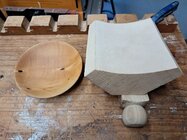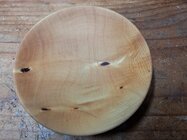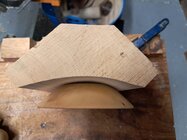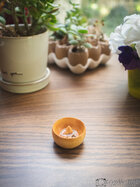As a result of this lovely PNW bomb cyclone that had us trapped in our house for several days, I've finally gotten the spur to do some tree elimination in our yard. There are two or three or four big leaf maples that should come down. Two of them are not big, but what is the reasonable minimum diameter for turning bowls? And if not bowls, is big leak maple suitable for turning if not too big in diameter? I believe that the sapwood is not much different than the heartwood in this species.
-
December 2025 Turning Challenge: Single Tree! (click here for details) -
Congratulations to Bob Henrickson, People's Choice in the November 2025 Turning Challenge (click here for details) -
Congratulations to Steven Gordon for "Dropped Ice Cream Cone" being selected as Turning of the Week for December 8, 2025 (click here for details) -
Welcome new registering member. Your username must be your real First and Last name (for example: John Doe). "Screen names" and "handles" are not allowed and your registration will be deleted if you don't use your real name. Also, do not use all caps nor all lower case.
You are using an out of date browser. It may not display this or other websites correctly.
You should upgrade or use an alternative browser.
You should upgrade or use an alternative browser.
Bigleaf Maple: minimum size for bowl turning?
- Thread starter John Snow
- Start date
I’m not sure there is a minimum. Just depends on what your bowl’s purpose is. Obviously a salad bowl should be bigger than a nut bowl. 
I quickly turned this reasonably small bowl a couple of weeks ago from some scrap wood laying around. Rather surprisingly, the number of people who want at least one bowl with this size and shape, is unbelievable. It is a bit rough, but from go to whoa, probably about 10 minutes max. Finish is rice bran oil.
It is a bowl as it has a continuous curve to the centre, it is not flat anywhere, the bottom has a wide base ring, with which I used Vicmarc jaws to hold. It measures 86mm across.
Terrible phone pictures, but you should get the idea.
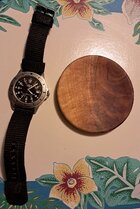
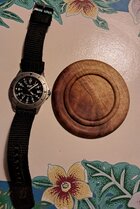
It is a bowl as it has a continuous curve to the centre, it is not flat anywhere, the bottom has a wide base ring, with which I used Vicmarc jaws to hold. It measures 86mm across.
Terrible phone pictures, but you should get the idea.


I don't think you have much too worry about- harvest it, process it, turn it, see what happens. You may get some happy surprises. As long as the young trees were old enough that its rubbery sappling-stage wood had turned to real wood (yeah, goofy thing to say, but hopefully gets the point across), you can make wonderful things from it, from palm-sized bowls like Mick shows, to any number of spindle projects. It's a soft maple, and will turn like typical soft maples (well, anything other than sugar, aka "rock" maple), so keep tools sharp and late stage cuts modest to light to help reduce grain tearout at the rotational transitions zones between face and side grain.
Big leaf also has such great potential for very strong figuring (tiger striping), especially in the mature trees in the trunk areas below larger limbs, and even into the bottom side of the limb itself. The weight of limbs compresses the fibers in the supporting/transitioning trunk/limb area creating the bold figuring stripes, it's beautiful stuff. If the tree is really big, if you study the bark in the "arm pit" area of the limb/trunk joint, you may see signs of compression even in the bark. I see that all the time in old silver maples, a similar, but rather boring in comparison, soft maple. All of this said, I'd leave it to a pro to drop the trees, esp. any big ones. Their extreme weight, and possible hidden rot inside the old ones, can spell disaster to the untrained sawyer.
I'm sorry that your area experienced nature's wrath, but I hope you're able to benefit in some way with those maples.
Big leaf also has such great potential for very strong figuring (tiger striping), especially in the mature trees in the trunk areas below larger limbs, and even into the bottom side of the limb itself. The weight of limbs compresses the fibers in the supporting/transitioning trunk/limb area creating the bold figuring stripes, it's beautiful stuff. If the tree is really big, if you study the bark in the "arm pit" area of the limb/trunk joint, you may see signs of compression even in the bark. I see that all the time in old silver maples, a similar, but rather boring in comparison, soft maple. All of this said, I'd leave it to a pro to drop the trees, esp. any big ones. Their extreme weight, and possible hidden rot inside the old ones, can spell disaster to the untrained sawyer.
I'm sorry that your area experienced nature's wrath, but I hope you're able to benefit in some way with those maples.
- Joined
- Feb 28, 2021
- Messages
- 1,770
- Likes
- 1,582
- Location
- Roulette, PA
- Website
- www.reallyruralwoodworks.com
Hmm.. If you were one like me that reads pretty much every new post on a daily basis here, You'd probably realize by now that there's no such thing as a minimum diameter... Not too long ago there were a couple posts (with pictures) of bowls smaller than a dime.. Goblets the size of toothpicks...but what is the reasonable minimum diameter for turning bowls?
- Joined
- Apr 27, 2004
- Messages
- 9,303
- Likes
- 6,058
- Location
- Lakeland, Florida
- Website
- www.hockenberywoodturning.com
I do shallow natural edge bowls from 4.5” diameter limbs and higher.
I cut the blank 2-4” longer than the round to feature the ovalness.
I usually cut the limbs in half through the pith.
On occasion I leave the pith.
I turn most of these footless - they aren’t tall enough to tip over.
They are fast to turn, easy to dry, easy to sand. Look nice with or without bark, People like them.
A 9 x 5 bowl 2” high looks terrific. If the wood is boring - colors can make it pop.
Small crotches are great too for NE bowls
If you have place to dry them for a year or cut some spindle stock with a bandsaw.
2x2, 3x3, 4x4. Coat the end with anchor seal end. Leave 1/2” air space between them and pit stickers between the layers
The in a year or so you can turn boxes, ornaments, spheres, tool handle…….
I cut the blank 2-4” longer than the round to feature the ovalness.
I usually cut the limbs in half through the pith.
On occasion I leave the pith.
I turn most of these footless - they aren’t tall enough to tip over.
They are fast to turn, easy to dry, easy to sand. Look nice with or without bark, People like them.
A 9 x 5 bowl 2” high looks terrific. If the wood is boring - colors can make it pop.
Small crotches are great too for NE bowls
If you have place to dry them for a year or cut some spindle stock with a bandsaw.
2x2, 3x3, 4x4. Coat the end with anchor seal end. Leave 1/2” air space between them and pit stickers between the layers
The in a year or so you can turn boxes, ornaments, spheres, tool handle…….
Last edited:
With whole logs, since I buy them now, I like 20 or more diameter. Earlier in my career, I would want 12 inch diameter or so because I could get one or 2 cores out of a blank. The problem with older BLMs is that the insides can be rotten. Some times a 4 foot diameter tree will have maybe 4 inches of sound wood on the outside and the inside is totally hollow.
robo hippy
robo hippy
I've wrestled with this type of question, as I'm the connector between people who are having trees cut down and our local club members (Chief Scrounger). My rule of thumb is 10-12" minimum for most woods, and 6-8" minimum for fruit woods. There's almost always more wood coming available in the not too distant future, so you have to weigh the cost of time and chain saws versus the benefit of the wood. Everybody's local circumstances are different. We aren't blessed with forests of hardwoods around here, so we value hardwoods more than many of you. YMMV.
One other thought would be the size of the rings. If they're wide, the wood might look funny in a small item. If they're narrow, or there's a lot of figure, then small size might look terrific.
One other thought would be the size of the rings. If they're wide, the wood might look funny in a small item. If they're narrow, or there's a lot of figure, then small size might look terrific.
You are right,I found that almost always,the big leaf maples of 2 Ft. or mor diameter is usually rotten in the centre. I find that to be really convenient though since then I will have bowl blanks nowhere near the pith. In my experience,anywhere even close to the pith is generally going to crack. Maple but especially alder.With whole logs, since I buy them now, I like 20 or more diameter. Earlier in my career, I would want 12 inch diameter or so because I could get one or 2 cores out of a blank. The problem with older BLMs is that the insides can be rotten. Some times a 4 foot diameter tree will have maybe 4 inches of sound wood on the outside and the inside is totally hollow.
robo hippy
Thanks, all. The trees I'm thinking about removing are young and maybe 8" max in diameter. I'll give it a go, anyway. Won't be free to cut the dang things down and I might as well try to keep some wood. The other thing I'm looking at is the Doug fir that came down across our driveway and trapped us for days. The bottom 20 feet is about 24" to 18" of clear wood (sap and heart); an eighty-year-old tree. Gotta think of something before the tree guys come back to clean up.
The Doug fir- lumber or boards. Find someone to cut it vertical grain for you. Gorgeous stuff.
Love it! Its great for a change tray, key tray, ring tray...so many uses.I quickly turned this reasonably small bowl a couple of weeks ago from some scrap wood laying around. Rather surprisingly, the number of people who want at least one bowl with this size and shape, is unbelievable. It is a bit rough, but from go to whoa, probably about 10 minutes max. Finish is rice bran oil.
It is a bowl as it has a continuous curve to the centre, it is not flat anywhere, the bottom has a wide base ring, with which I used Vicmarc jaws to hold. It measures 86mm across.
Terrible phone pictures, but you should get the idea.
View attachment 69024
View attachment 69025
In addition to the little tray Mick shared, you could also turn endgrain bowls. These are easy to turn, like hollowing a box. They can be small, and work great for the same things...change, keys, rings, screws or other loose parts, etc. etc.As a result of this lovely PNW bomb cyclone that had us trapped in our house for several days, I've finally gotten the spur to do some tree elimination in our yard. There are two or three or four big leaf maples that should come down. Two of them are not big, but what is the reasonable minimum diameter for turning bowls? And if not bowls, is big leak maple suitable for turning if not too big in diameter? I believe that the sapwood is not much different than the heartwood in this species.
We aren't blessed with forests of hardwoods around here, so we value hardwoods more than many of you.
That fact sometimes hard to remember for those of us who literally live in forests of hardwoods. We are so spoiled. Green hardwood here is basically free for anyone who can cut or haul, and sometimes even if they can’t. Big trees often come down, especially if there’s a strong wind after a couple of days of rain. Almost all of it is left on the ground to rot. It’s less common to find small diameter windfall trees.
Right now I have a pile of american ebony (persimmon), cut into 18” lengths, sealed on the ends, waiting until I have time to process it. A guy brought dogwood last week and he has more if I want it. I have several big cherry, walnut, oak, sourwood, hackberry, persimmon, y.poplar, and sassafras trees on our property alone that seriously need to come down. Wood, wood, wood.
I don’t run my sawmill as much these days, but here sits a pile of big hardwood logs to saw into siding for a new horse shelter. When I get more than I and friends can use, there’s a local guy who will come with a chainsaw and truck, splits and hauls - he makes his living selling (hardwood) firewood.
I wish we had a magic portal that could instantly transport logs and chunks to woodturners across the country.
Hahah, Funny!I’m not sure there is a minimum. Just depends on what your bowl’s purpose is. Obviously a salad bowl should be bigger than a nut bowl.
If you don't limit yourself to bowls only there are many small projects that can be made from small trees and limbs especially if you include the pith / full round. The choices include end grain goblets with or without natural edge, boxes. containers, hollow forms, end grain bowls and experiment with any other idea you can think of.
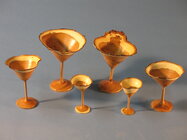 The cherry goblets are all turned from small trees, the left center at 3rd from left came from a piece less the 2" (50mm) diameter and you can see the pith running thru the stem.
The cherry goblets are all turned from small trees, the left center at 3rd from left came from a piece less the 2" (50mm) diameter and you can see the pith running thru the stem.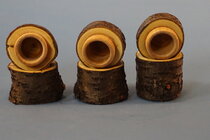 These 3 boxes were made fro buckthorn about 2" diameter.
These 3 boxes were made fro buckthorn about 2" diameter.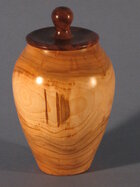 This is a small keepsake urn in black cherry and the tree was between 3 & 4" diameter.
This is a small keepsake urn in black cherry and the tree was between 3 & 4" diameter.
 The cherry goblets are all turned from small trees, the left center at 3rd from left came from a piece less the 2" (50mm) diameter and you can see the pith running thru the stem.
The cherry goblets are all turned from small trees, the left center at 3rd from left came from a piece less the 2" (50mm) diameter and you can see the pith running thru the stem. These 3 boxes were made fro buckthorn about 2" diameter.
These 3 boxes were made fro buckthorn about 2" diameter. This is a small keepsake urn in black cherry and the tree was between 3 & 4" diameter.
This is a small keepsake urn in black cherry and the tree was between 3 & 4" diameter.Hi Mick,
I'm unfamiliar with rice bran oil as a bowl finish. Does it polymerize? Are there particular kinds of pieces you like using it on? Lovely little bowl, by the way. Thanks!
I'm unfamiliar with rice bran oil as a bowl finish. Does it polymerize? Are there particular kinds of pieces you like using it on? Lovely little bowl, by the way. Thanks!
I quickly turned this reasonably small bowl a couple of weeks ago from some scrap wood laying around. ... Finish is rice bran oil
Hi Mick,
I'm unfamiliar with rice bran oil as a bowl finish. Does it polymerize? Are there particular kinds of pieces you like using it on? Lovely little bowl, by the way. Thanks!
A google search indicates rice bran oil is food safe, is absorbed into the wood, protects. I didn't find more info yet but I suspect it is a non-polymerizing used similar to the oils often applied to cutting boards and other things like rolling pins used in the kitchen. Should work well for a bowl, might need to be reapplied occasionally. I sometimes use bamboo oil on wood in the kitchen. Any oil brings out the figure in olive.
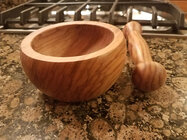
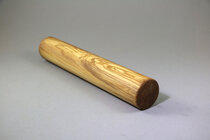
I agree, the tiny, shallow bowl looks great. I not much interested in turning more large bowls but I might do some small ones like that. Would be great for jewelry, a watch, stamps, paper clips.
Or when someone wants a cookie and instead of bring the whole container I bring just one.
@John Snow
Big leaf maple is not so common around here. What I've had was beautiful wood, often figured, some burl. Since I rarely turn green wood if I got some I'd cut it into turning blanks for drying. Even small trees can yield a LOT of blanks for spindles, boxes, pepper mills, and far more.
JKJ
Last edited:
Question regarding small trees for turning stock. Do you just include the pith in the blanks? Looking at methods for cutting blanks from logs it looks like you always cut out the pith. This would seem to be near impossible on smaller diameter logs.Even small trees can yield a LOT of blanks for spindles, boxes, pepper mills, and far more.
Gregory
Question regarding small trees for turning stock. Do you just include the pith in the blanks? Looking at methods for cutting blanks from logs it looks like you always cut out the pith. This would seem to be near impossible on smaller diameter logs.
Gregory
Almost never. Juvenile wood can be unstable (in many species but not all) and cause splits and cracks to start. Some species (e.g. Dogwood) can even be problematical if the heartwood and the sapwood are on the same face of the blank. Remember, this is all wood I cut and dry - cut and turned immediately and perhaps thin while wet can have different "rules". For example, people often use limbs to turn small goblets and things with the pith left in, sometimes interesting natural edge goblets with the bark left on, such as Don showed in post #17 above.
Also, when drying blanks I always seal the end grain but SOMETIMES seal certain side grain, again, depending on the wood and some other factors of how wood warps and relieves stress by cracking with drying. Several good books can help with understanding this.
From small log sections I can cut and dry thin blanks for spindles, from 3/4" and larger. I've done with with logs sections that were no more than 3-4" in diameter. (Saw down the pith first to split into two halves, then whittle away to get the best blanks possible from the log section.) I keep 100s of such dry blanks in my wood stash - so many potential uses! I have one box of dry blanks I made specifically for those who turn pens - some are beautiful burls, spalted, and exotic woods.
JKJ
Hi Mick,
I'm unfamiliar with rice bran oil as a bowl finish. Does it polymerize? Are there particular kinds of pieces you like using it on? Lovely little bowl, by the way. Thanks!
I inadvertently replied via message to Sarah, thinking I was replying in this thread. I clicked on the wrong thing in the email notification, again. This was my message to Sarah.
Sarah, thank you for your kind words with regard to my bowl.
As for Rice Bran Oil (RBO), well there was a shortage of Boiled Linseed Oil (BLO) during last winter for whatever reason, and as a result the price of BLO went through the roof, so I looked around and happened to see one of Richard Raffan's videos where he was using RBO, which was something I hadn't thought of. So I gave it a go as the cost for a 500ml bottle from Aldi was so cheap I had nothing to lose, and if things weren't good it could be used for cooking.
It has been a success, not a total success, but for timber that can handle the slight darkening, which usually brings out features on/in the timber, it is my go to oil these days. To answer your specific question about polymerising, I don't really know. This summer I've probably finished around 3 bowls a week, with around 4 out of 5 of those bowls finished with RBO, or another way, 80% have been finished with RBO.
Hopefully I've attached a few images, one is a finished bowl, which is Huon Pine, it is 120mm across and you may be able to see the growth rings; there are approximately 10 growth rings for every 10mm, which means that this section of tree shows 120 years of growth rings. Huon Pine comes from the Huon Valley in Tasmania and is irreplaceable as trees take around 1,000 years to reach maturity, their life span is estimated at 1,000 to 3,000 years. The wood has its own oil and it is a waterproof wood, and was used extensively for sailing ships. It is a protected species and all timber these days is retrieved from the bottom of rivers, where some of it is believed to have lain underwater for a couple of thousand years.
Consequentially, I've never purchased any Huon Pine, but I was lucky enough to be donated the offcuts of a fellow woodturner who purchased an approximately 450mm x 450mm by 190mm high piece of Huon Pine to make a largeish (for Huon Pine) bowl. My bowl shown below, is made from one of the three offcuts that were usable. One picture is of one of the offcuts and the finished bowl, which should show the difference in colour obtained on this timber with RBO.
Huon Pine, I found out, cannot be finely sanded, the sandpaper just oils up. I started at 120 grit, then progressed through the grits until 180 grit. Once I applied 240 grit, the sandpaper basically just oiled up. Regardless, this first of three bowls is wonderfully smooth and feels as though 600 grit has been used. One is always learning!
A link to Huon Pine, which I've just found out, is not a pine after all!!!!

Lagarostrobos - Wikipedia
